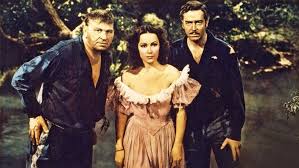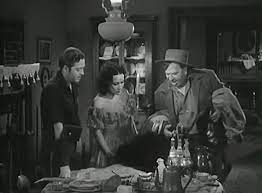🎬 The Man from Dakota (1940)

The Man from Dakota (1940) Review: A Gritty Civil War Drama of Loyalty and Survival
Directed by Leslie Fenton and based on MacKinlay Kantor’s novel of the same name, The Man from Dakota is a stirring Civil War-era drama that blends action, suspense, and character-driven storytelling. Starring Wallace Beery, John Howard, and Dolores del Río, the film explores themes of loyalty, survival, and unexpected camaraderie as three characters from vastly different backgrounds are thrust together during the chaos of war. With its mix of gritty realism and moments of humor, The Man from Dakota offers a unique perspective on the American Civil War.
Plot Overview: An Unlikely Alliance
The film begins during the tumultuous days of the Civil War. Barney Glasgow (Wallace Beery), a rough-and-tumble Union Army deserter, is on the run when he encounters Oliver Clark (John Howard), a Union officer falsely accused of cowardice. The two men form an uneasy alliance as they escape capture and navigate the war-torn South.
Their journey takes a surprising turn when they meet Jenny Sanford (Dolores del Río), a spirited and resourceful Southern woman trying to survive in the midst of destruction. The trio’s interactions provide a compelling exploration of clashing ideologies, personal redemption, and the shared humanity that transcends political divisions.
Wallace Beery as Barney Glasgow: A Rugged Antihero
Wallace Beery delivers a memorable performance as Barney Glasgow, blending his signature gruff charm with moments of vulnerability. Glasgow’s character is a far cry from a conventional hero—self-serving and cynical—but Beery imbues him with enough humanity to make his eventual transformation believable and compelling. His chemistry with both Howard and del Río adds depth to the story.
John Howard as Oliver Clark: Honor Under Fire
John Howard brings sincerity and gravitas to the role of Oliver Clark, a man determined to clear his name and uphold his honor. Howard’s portrayal emphasizes Clark’s sense of duty and moral clarity, serving as a counterbalance to Glasgow’s rough-edged pragmatism. His evolving relationship with Glasgow forms the emotional backbone of the film.
Dolores del Río as Jenny Sanford: Strength and Resilience
Dolores del Río shines as Jenny Sanford, a character who represents the resilience of women during wartime. Del Río’s performance is nuanced and layered, capturing Jenny’s strength, intelligence, and unyielding determination. Her presence adds emotional depth to the narrative, and her interactions with Beery and Howard provide some of the film’s most engaging moments.
Themes: Survival, Redemption, and Humanity Amid Conflict
- Redemption: Both Glasgow and Clark undergo personal transformations, learning to trust one another and finding redemption through their shared experiences.
- Survival: The film emphasizes the harsh realities of war, with characters forced to make difficult choices to ensure their survival.
- Humanity Beyond Divisions: Despite their differing backgrounds and allegiances, Glasgow, Clark, and Jenny find common ground, illustrating the shared humanity that persists even in times of conflict.
Direction and Cinematography: A Blend of Grit and Heart
Leslie Fenton’s direction balances action-packed sequences with quieter, character-driven moments. The film’s visual style captures the bleakness of the Civil War, with atmospheric shots of desolate landscapes and war-ravaged towns. Cinematographer Sidney Wagner enhances the storytelling with his effective use of shadow and light, creating a sense of tension and realism.
Key Moments That Define The Man from Dakota
- The Escape from Confederate Forces: Early in the film, Glasgow and Clark’s harrowing escape sets the tone for the high-stakes drama that follows.
- Meeting Jenny Sanford: Jenny’s introduction brings a fresh dynamic to the story, challenging both Glasgow’s cynicism and Clark’s rigid idealism.
- The Final Confrontation: The film’s climax delivers an emotionally charged resolution, highlighting the characters’ growth and the sacrifices they’ve made.
Strengths of The Man from Dakota
- Strong Performances: Beery, Howard, and del Río each deliver compelling portrayals that bring depth and complexity to their characters.
- Character-Driven Narrative: The film’s focus on personal relationships and moral dilemmas adds emotional weight to the story.
- Blend of Realism and Humor: Moments of levity balance the grim realities of war, making the characters relatable and the narrative engaging.
Weaknesses of The Man from Dakota
- Simplified Historical Context: While the film captures the spirit of the Civil War, its focus on personal stories limits its exploration of broader historical themes.
- Predictable Plot Points: Some elements of the story, such as Glasgow’s redemption arc, follow familiar patterns.
- Underdeveloped Supporting Characters: Aside from the central trio, many supporting roles are not fully fleshed out.
Legacy and Reception
While The Man from Dakota may not be as widely recognized as other Civil War dramas, it remains a noteworthy entry in the genre for its strong performances and unique perspective on wartime survival and camaraderie. Its emphasis on character-driven storytelling and its depiction of unlikely alliances resonate with audiences who appreciate nuanced narratives.
Fun Facts About The Man from Dakota
- Adaptation of a Novel: The film is based on MacKinlay Kantor’s novel, which was praised for its detailed portrayal of Civil War life.
- Wallace Beery’s Versatility: Known for his comedic and dramatic roles, Beery brought his trademark charm to the role of Glasgow, making the character both humorous and poignant.
- Dolores del Río’s Impact: As one of the first Mexican actresses to achieve international fame, del Río’s presence in the film added star power and a unique dimension to the story.
Conclusion: A Thoughtful and Engaging Civil War Drama
The Man from Dakota (1940) is a compelling exploration of survival, redemption, and unlikely friendships during the Civil War. Anchored by strong performances from Wallace Beery, John Howard, and Dolores del Río, the film balances gritty realism with heartfelt moments, creating a narrative that resonates on both personal and historical levels. While it may not delve deeply into the larger context of the war, its focus on character and moral dilemmas makes it a worthwhile watch for fans of classic cinema and historical dramas.